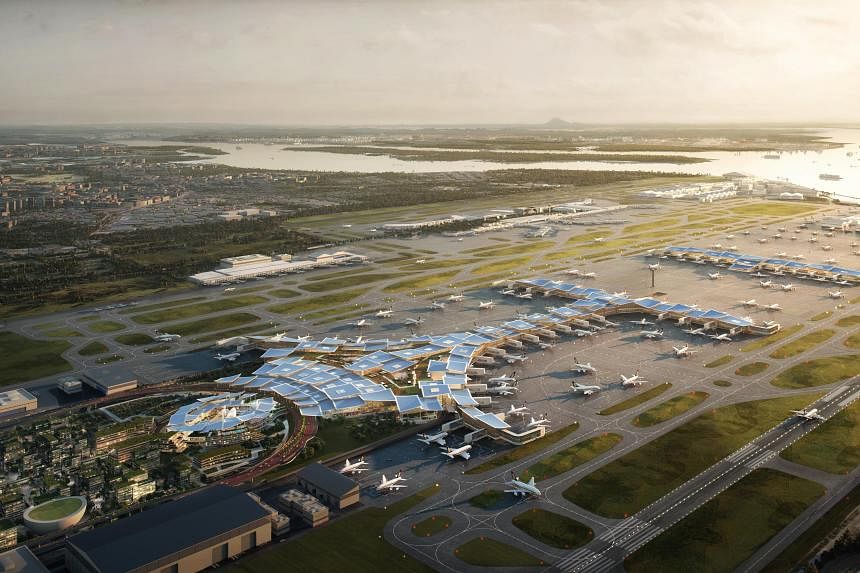SINGAPORE – A 2.5km-long underground link will be built to connect the future Changi Airport Terminal 5 (T5) with the existing Terminal 2 (T2). It comprises tunnels for an automated people-mover system – similar to today’s Skytrain – and a separate system to handle baggage.
Part of ongoing infrastructural works at the new 1,080ha Changi East development, the T2 Connection will link T5 with Changi’s existing terminals when the mega terminal opens in the mid-2030s, the Civil Aviation Authority of Singapore (CAAS) told The Straits Times in response to queries.
New details about this inter-terminal underground link were first reported by Chinese-language daily Lianhe Zaobao on April 14.
Earlier in February, construction work for the T2 Connection at Changi East appeared as a new line item in the Government’s projected development expenditure for Budget 2024, with a total project cost exceeding $722 million.
Preparatory work for the new underground link is already under way.
According to stock exchange filings, the Singapore subsidiary of Chinese construction firm Shanghai Tunnel Engineering Co was awarded a $622 million contract in October 2023 by airport operator Changi Airport Group (CAG) to design and build underground structures for the new T2 underground link.
The contract, which also includes the restoration of airport infrastructure and road surfaces that are affected by the works, has a projected completion date of October 2028.
Plans to dig a series of tunnels to move bags and people between the future T5 and the current airport, which will be separated by surface taxiways and one of the airport’s runways, have been in the works for years now.
ST reported in 2017 that CAG already had plans then to build a 9m-wide tunnel for bag transfers for travellers with connecting flights, and tunnels more than 6m wide in each direction for an underground train system between T5 and T2.
It is not clear if these plans have changed since then, given the Covid-19 pandemic and subsequent redesign of T5 to make it more modular. CAAS and CAG did not respond to queries asking for more details about the future T2 Connection.
Mr Mayur Patel, head of Asia at aviation data consultancy OAG Aviation, said inter-terminal connectivity is a key element for a major air hub like Changi, and an underground link between T2 and T5 will allow for seamless transfers between flights.
He mentioned, for instance, passengers who may need to arrange their own flight connections at the airport, usually from a full-service airline to a low-cost carrier under two different tickets, or from one low-cost carrier to another.
“For this, you need a good transport network within the airport environment,” Mr Patel said. “With changing consumer trends among next-generation travellers, airports will need to be built to accommodate the changing demographics.”
He said a useful benchmark for T5 could be Hong Kong International Airport, which is also being expanded.
A new 2.6km underground automated people-mover system is being built there, which will operate at a top speed of 80kmh and transport 10,800 passengers per hour. The expanded Hong Kong airport will also get a new underground baggage handling system capable of moving 9,600 bags per hour.
Meanwhile, public transport and road connectivity will be an integral part of the supporting infrastructure for T5 as well, said Mr Patel.
He cited future plans for a direct connection between T5 and Tanah Merah Ferry Terminal, as well as a future Thomson-East Coast MRT Line extension that will pass through T5, linking the upcoming Sungei Bedok station with Changi Airport.
Transport engineering consultant Gopinath Menon said the new T5 cannot do without driveways, service roads and linking roads.
While the MRT may be the major public transport mode for travellers, buses and taxis are also important, and surface roads are a fallback for connectivity should there be a failure in any other moving systems, he said.
“Much attention has to be paid to way-finding on the approaching roads, outside and inside the terminals,” Mr Menon added.
First announced in 2013, construction of T5 was meant to start around 2020, but the project was paused for two years due to the Covid-19 pandemic.
Work resumed in 2022, and construction of the new terminal is now expected to start in 2025.
When operational, T5 will be able to handle up to 50 million passengers a year. This is more than the current capacities of Terminals 1 and 3 combined.


